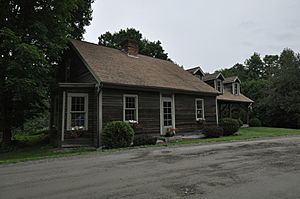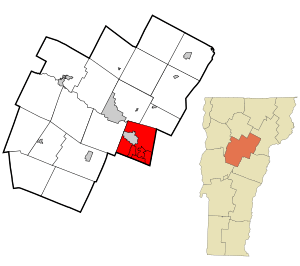Barre (town), Vermont facts for kids
Quick facts for kids
Barre, Vermont
|
|
|---|---|
 |
|

Location in Washington County and the state of Vermont
|
|
| Country | United States |
| State | Vermont |
| County | Washington |
| Communities |
|
| Area | |
| • Total | 30.7 sq mi (79.5 km2) |
| • Land | 30.6 sq mi (79.4 km2) |
| • Water | 0.1 sq mi (0.1 km2) |
| Elevation | 988 ft (301 m) |
| Population
(2020)
|
|
| • Total | 7,923 |
| • Density | 258/sq mi (99.8/km2) |
| Time zone | UTC-5 (Eastern (EST)) |
| • Summer (DST) | UTC-4 (EDT) |
| ZIP Codes | |
| Area code(s) | 802 |
| FIPS code | 50-03250 |
| GNIS feature ID | 1462036 |
Barre (pronounced BARR-ee) is a town in Washington County, Vermont, in the United States. In 2020, about 7,923 people lived there. This makes it the 16th largest town in Vermont.
Barre is often called "Barre Town." It almost completely surrounds another place called "Barre City." Even though they are very close, they are two separate communities.
The town of Barre was first created in 1780. It was originally named Wildersburgh. But people didn't like that name, so in 1793, it was changed to Barre. Later, in 1895, Barre City became its own separate place. Both Barre Town and Barre City still exist today.
Contents
Exploring Barre's Location and Landscape
Barre Town covers about 30.7 square miles (79.5 square kilometers). Most of this area is land, with only a small part being water.
Barre is famous for its granite. It even calls itself the "Granite Center of the World." Huge amounts of granite were found at a place called Millstone Hill after the War of 1812.
The Rise of the Granite Industry
The granite business grew a lot when the railroad arrived. This made it easier to transport the heavy stone. Geologists say the granite deposit is huge. It's about 4 miles (6.4 km) long, 2 miles (3.2 km) wide, and 10 miles (16 km) deep!
News of this amazing granite spread far and wide. People came to Barre from many countries. They came from Italy, Scotland, Spain, Scandinavia, Greece, Lebanon, and Canada.
Population Growth and Recreation
Because of the granite industry, Barre's population grew very quickly. In 1880, there were about 2,060 people. By 1894, there were around 10,000 people!
Today, Millstone Hill and the nearby Barre Town Forest are popular spots for outdoor activities. You can find hiking trails there. You can still see old mining holes and piles of rock from when the granite was dug out.
Who Lives in Barre?
| Historical population | |||
|---|---|---|---|
| Census | Pop. | %± | |
| 1800 | 919 | — | |
| 1810 | 1,669 | 81.6% | |
| 1820 | 1,955 | 17.1% | |
| 1830 | 2,012 | 2.9% | |
| 1840 | 2,126 | 5.7% | |
| 1850 | 1,845 | −13.2% | |
| 1860 | 1,839 | −0.3% | |
| 1870 | 1,882 | 2.3% | |
| 1880 | 2,060 | 9.5% | |
| 1890 | 6,812 | 230.7% | |
| 1900 | 3,346 | −50.9% | |
| 1910 | 4,194 | 25.3% | |
| 1920 | 3,882 | −7.4% | |
| 1930 | 4,280 | 10.3% | |
| 1940 | 4,052 | −5.3% | |
| 1950 | 4,145 | 2.3% | |
| 1960 | 4,580 | 10.5% | |
| 1970 | 6,509 | 42.1% | |
| 1980 | 7,090 | 8.9% | |
| 1990 | 7,411 | 4.5% | |
| 2000 | 7,602 | 2.6% | |
| 2010 | 7,924 | 4.2% | |
| 2020 | 7,923 | 0.0% | |
| U.S. Decennial Census | |||
In 2000, there were 7,602 people living in Barre. There were about 2,951 households, which are groups of people living together.
Most people in Barre are White (98.47%). A small number of people are from other racial backgrounds. About 1.51% of the population identified as Hispanic or Latino.
Families and Age Groups
About 34.4% of households in Barre had children under 18 living with them. Many households (64%) were couples living together.
The population is spread out across different age groups. About 25.6% of the people were under 18 years old. The average age in Barre was 40 years.
Learning in Barre
Barre Town has its own public school called Barre Town Middle and Elementary School. Students from pre-school all the way through eighth grade go there.
For high school, students attend Spaulding High School. This school is located in Barre City. There are also private schools in Barre Town. These include Websterville Christian Academy and the Montessori School of Central Vermont.
Famous People from Barre
Many interesting people have connections to Barre. Here are a few:
- Jodi Cilley, a film producer and educator.
- Lui Collins, a folk singer and songwriter.
- Madelyn Davidson, who was the Vermont State Treasurer.
- Norman Dubie, a well-known poet.
- D. C. Jarvis, a physician.
- Miranda July, an artist, musician, writer, and film director.
- Dave Moody, a commentator for NASCAR races.
- Katherine Paterson, a famous author who has won awards for her children's books.
- Tracey Poirier, a brigadier general in the Vermont National Guard.
- Helen Bonchek Schneyer, a folk musician.
See also
 In Spanish: Barre (condado de Washington, Vermont) para niños
In Spanish: Barre (condado de Washington, Vermont) para niños


